History of Our Lady Comforter of the Afflicted Church
The Catholic Church of Our Lady Comforter of the Afflicted in Waltham, Massachusetts came into existence as the United States was entering the time of severe economic testing known as the Great Depression. In later years, its history would cover the periods of disruption brought by the Second World War, the Korean War and the Vietnam War. But through all these years,, people of the parish have turned to Our Lady and found comfort for their national, local and personal afflictions. Looking back of many, many years of ministry to this community, it reaffirms its faith in Mary's words of the Magnificat: "His mercy reaches from age to age for those who fear him."
As the decades of the 1920s moved toward its close, Father James J. Baxter, pastor of St. Mary's Church in Waltham, began to see the need for a new parish. On January 4, 1928, he bought a lot for a future church at the corner of Trapelo Road and Bow Street. The area was mostly woods and farmland, and not a great many people lived in the immediate vicinity at the time. But Father Baxter saw that it was the exact center of an area that would need a church. The Catholics already living there needed a more conveniently located church. It seemed evident that this was the only part of Waltham still offering space for development.
Other factors in establishment of the new parish were the building of the Middlesex County Sanatorium, Metropolitan State Hospital and the Fernald School in the area, as well as the need for a ministry to people of these new institutions. These institutions were responsible for the name given to the new church. An initial suggestion was to call it the Church of the Holy Cross. But Cardinal William Henry O'Connell, Archbishop of Boston from 1907 until his death in 1944, noted that the pastor would care for the hospitals and said that an appropriate name would be Our Lady Comforter of the Afflicted. So it became.
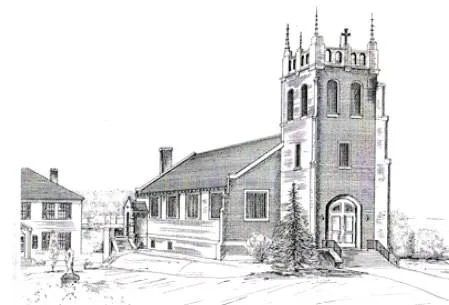
On January 14, 1929, The News Tribune reported: "A division of St. Mary's Parish and the creation of a new parish in North Waltham section by orders of Cardinal O'Connell." These announcements came as a surprise to the parishioners of St. Mary's in connection with the presentation of the annual report of the parish by the pastor, Reverend James J. Baxter. The pastor announced that a parish is to be formed with boundary lines extending on a line from Lincoln at the West, to Waverly at the East and from College Farm Road to Concord Avenue, which is the boundary at the Lexington end. The new parish will include the Walter E. Fernald School and the new state hospital, and it is estimated that there will be a parish of approximately 400 to be served at the start, with indications of a rapid growth because of the state institution.
It was the suggestion of the pastor that the new parish might be appropriately named the Parish of the Holy Cross, since the name Waltham came from the name of the old town in England in which the parish of the Holy Cross is located. Father Baxter stated that he had been authorized to take down the chapel which had been erected in Waverly at the time of his pastorate there and use the materials for the culding of the church for the new parish here. He purchased the land some time ago, on Trapelo Road and the building of the new church will be started without delay. He said that there is ample supply of fieldstone on the area for the foundation and the lumber of the chapel will go a long way toward erection of the building. The cost will be held as low as possible and the expense of the entire project must be borne by the parish which is newly created. The pastor will no be assigned until the new church is in readiness for occupants. The erection of the edifice will be supervised by Reverend Father Baxter. Later, Father Baxter decided to assume responsibility himself for the cost of the new building.
Shortly after the news account appeared on January 23, Father Baxter wrote to the cardinal's secretary: "There is no need of conveying a title to Old St. Luke's Chapel, Waverly. Father Richard Splaine proposed to sell it to me for $500, and I find I can save money by buying it, having it taken apart and transported (about two miles) to the new lot in North Waltham. The idea is to erect a church of the same size - 40 x 80 feet - without basement except for boiler room; walls to be of fieldstone already on the lot, to a height of six feet, superstructure of St. Luke's lumber veneered with a stone-gray brick, and a roof of slates lately presented to me free. The lighting, plumbing and heating materials can all be reinstalled. To which building commissioner should I submit plan? And may I have a loan of $25,000?"
Cardinal O'Connell was apparently not troubled by deciding how to deal with a priest who explained at length his need to spend five hundred dollars and ended by casually throwing in a request for a loan of twenty-five thousand dollars. The cardinal's secretary replied that permission was granted to buy the chapel and blandly ignored the request for a loan.
Edward T. Sheehan had been commissioned to draw up plans for the new church. After bids were secured from several contractors, the job was given to John Capobianco Construction Company. Ground was broken on April 2, 1929 and a permit for construction was dated April 24.
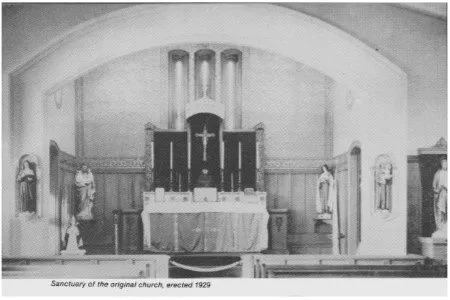
In October, Father Baxter wrote the Chancellor, giving another report to His Eminence. He now could report that the church was "completed and fully equipped for service." A census had found that whoever was sent as pastor for the new parish would get one hundred and seventy-five families from St. Mary's Parish plus an unknown number from Lexington. And then Father Baxter went on to describe the general situation that would face the first pastor at the Church of Our Lady Comforter of the Afflicted: "His work will be exceedingly disagreeable and laborious. It is useless to appoint an old curate in his fifties. The man should be a real apostle to the down-and-out, ten or twelve years ordained, and with considerable means of his own. He should be instructed to put in the cellar of a rectory immediately, and build the wooden superstructure during the winter. He will be welcome to live at St. Mary's in the meantime. It is to be hoped that, according to custom, the surrounding parishes will give him the usual donation, for at first he will find it hard to make a living. The lot cost $2,000; the total building and furnishing cost was about $43,000. The new pastor will start free of debt, as I propose to carry the burden myself and pay it off gradually. Our Lady has often been to me a Comforter in affliction, and I am happy to do this, both as an offering at her shrine, and as a donation to the diocese."
For six months after completion of the church, Cardinal O'Connell was unable to assign a pastor, and he asked St. Mary's priests to take interim responsibility. So an assistant at St. Mary's, Father Waldo Hasenfus, offered Mass on Sundays and Holy Days, administered the sacraments and took census.
The parish was officially established on April 22, 1930, with the appointment of Father Alfred J. MacDonald as the first pastor.

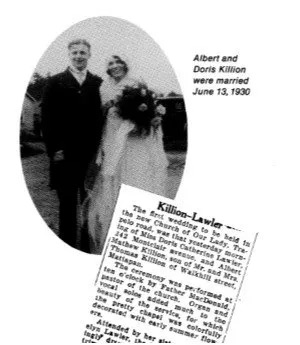
Two months later, the first wedding to be held in the new Church of Our Lady was that of Albert and Doris Killion who were married on June 13, 1930.
Before arriving at Our Lady's, Father MacDonald had been serving as assistant at St. Ann's Church in Gloucester. He immediately set to work building the rectory, and it was completed on October 19, 1930. D. Lovetere of Roslindale made the lowest bid for the rectory-seven thousand eight hundred and twenty-five dollars, plus two thousand one hundred and seventy dollars for plumbing and heating, making a total of just five dollars less than ten thousand dollars. On July 10, 1930, a permit for building the rectory was obtained, and on August 18, Cardinal O'Connell signed a note for an eleven-thousand dollar loan from the Marlborough Savings Bank.
On September 5, he gave permission for construction of a two car garage and for furnishing of the rectory. The garage permit was obtained on November 10. The following April the Cardinal approved expenditure of another thirty dollars for lightning rods for the church and rectory. When the parish celebrated its silver jubilee in 1955, a historian wrote in the booklet published for the occasion: "For five years Father MacDonald labored in the parish despite many handicaps, but his desire to do God's will and organize the parish more fully gave him the strength to carry on and with the support of many of the faithful his labors and burdens were made light."
Many of the old-timers remember Father MacDonald. Genial and friendly with a fine sense of humor, yet stern and unyielding when he felt that the good of religion and the Church of Christ was concerned. Dedication services for the Church of Our Lady Comforter of the Afflicted were held on June 7, 1931. The News Tribune reported the next day: "Officiating at a double ceremony which included the blessing of the Church of Our Lady Comforter of the Afflicted on Trapelo Road, and the conferring on a class of 50 the Sacrament of Confirmation, the Right Reverend Bishop John B. Peterson, D.D., pastor of St. Catherine's Church in Somerville, paid a glowing tribute to the unfaltering enthusiasm of Reverend James J. Baxter, D.D., pastor of St. Mary's, which almost entirely made possible the North Waltham parish's founding." It was also reported that Our Lady's Parish had grown steadily since its founding.
Another landmark in the development of the parish came on March 1, 1934 when faculties were received for canonical erection of Stations of the Cross in the church.
Father MacDonald was transferred to the pastorate of St. Michael's Church in North Andover in 1935, which also turned out to be the year of Father Baxter's death at St. Mary's. The year 1935 was memorable also because the Sisters of Notre Dame de Namur, stationed at St. Mary's, were given charge of Our Lady's Sunday School that fall. Established in 1804, this order had its motherhouse in Namur, Belgium, until it was transferred to Rome in 1957.

Our Lady's second pastor was Father Edward P. Twigg, who came from All Saints Church in Roxbury. He found the work of the parish, combined with the ministry of two hospitals, beyond the capacity of a single priest, and consequently petitioned Cardinal O'Connell for an assistant. The cardinal responded by sending a newly-ordained priest, Father James J. McWade, to begin work on May 28, 1935 as the first curate of the church. Father Twigg was transferred in 1937 and succeeded by Father Patrick J. Quill who served until 1940. During the years of World War II, the pastor following Father Quill was Father Joseph M. Holland. He came to the parish on July 31, 1940 from Sacred Heart in Lynn and remained until November 1946 when he was transferred to St. Monica's Church in Methuen.
Father Holland's pastorate was a difficult time because many men of the parish were away serving with the military. At home, the women were organized into defense units. And everyone lived with the anxiety of knowing that any day might bring a message that some relative or friend had been killed in combat. But parish life went on, with its spiritual ministry of reminding members where they could find comfort in their days of affliction, and with the many more prosaic activities required to sustain a functioning parish. In 1944, for example, Father Holland had the rectory insulated at a cost of five hundred and fifty dollars. Shortly after the war, on March 28, 1946, he got permission from Archbishop (later cardinal) Richard Cushing, who had succeeded Cardinal O'Connell, to spend approximately thirty-five hundred dollars for repairs and repainting of the church and rectory.
In November of that year, Father Holland was transferred and Father Percival J. Quill (not related to Father Patrick J. Quill) came as his successor. The following year, Cardinal Cushing gave Father Percival Quill permission to spend four thousand dollars for improvements on the church. Renovation at this time included refinishing the sanctuary wall and installing many new furnishings, including an altar, reredos, candlesticks, crucifix, sanctuary lamp, pair of pedestals, communion rail and carpet. Most of these latter items were donated. A statue of Our Lady was placed on the lawn.
Father Percival Quill was pastor of Our Lady's until 1949 at which time Father Joseph H. Bernard became pastor on June 13, 1949. By this time, may new homes had been built in the area and the membership of the parish had more than doubled. To provide space for an expanding program, a parish hall was built in excavated space under the church. It was used for Sunday School, a children's Mass on Sundays, various group meetings and social occasions.
As a result of a new housing project, the number of Masses was increased by four in the fall of 1950. 1 1953 census count showed a parish membership of seventeen hundred and forty-two.
Organizations that were now enriching the life of the parish included the Sodality of the Blessed Virgin, the Holy Name Society and Legion of Mary. Parishioners also gather in the church every evening at seven o'clock to recite the rosary. In the silver jubilee booklet of 1955, the historian, after paying tribute to the priests who had serve the parish, continued: "Nor must we forget the Sisters of Notre Dame, who, during these twenty-five years, have trained our boys and girls by their teaching in Sunday School, but most of all, by their example, have impressed on them high ideals of duty and a sense of responsibility go God."
It remains to say a word of sincere appreciation and deep gratitude to that band of parish workers who during the twenty-five years, toiled so unselfishly and kept alive the fire of loyalty and devotion. Many of them have gone to their reward; many other have moved to other parishes, but we are still blessed with loyal, generous helpers. As the newcomers read this story and the old-timers remember back to difficult days of the past through their minds run pictures of endless garden parties, plays and whist parties for their fellow workers, and of little half-forgotten incidents, a mist forms in their eyes and a pain comes into their hearts.
And just as in the time of Our Lord the Holy women ministered to Him and played such an important part, so in the story of Our Lady's Parish we find a long line of other holy women ministering to the Church, which is His Spouse, and constituting the backbone of every effort that was made for her improvement. And let us not forget to express our appreciation for the work and loyalty of the many good men who then and now have played a part in the success of our parish.
In 1956, Father (later Monsignor) Edward T. Harrington became pastor of Our Lady's Church and served until 1973, the longest pastorate in the church's half century of existence.
The Chancellor gave permission in November of 1956 for extensive renovation of the rectory interior and purchase of new furnishings. The exterior was also in poor condition and in 1960 new siding was put on. Also in 1960, Father Beaudoin got permission to celebrate a dialogue Mass each Friday at 7 p.m. A lay group was meeting weekly to practice the recitation of responses.
The outstanding event of Monsignor Harrington's pastorate was the construction of a new church and school. This involved first a rather complicated process of acquiring a new lot of adequate dimensions for the new buildings. On September 9, 1957, Monsignor Harrington wrote Monsignor Robert J. Sennott, Chancellor of the Archdiocese, to report that Eliza W. Reed had given land across the street from the church, and to request that Cardinal Cushing write her a note of thanks. He added, however, that she did not want the gift publicized. In another letter, dated December 1, 1958, Monsignor Harrington requested a similar note of thanks for Mr. and Mrs. Matteo Grillo, who had made a "very generous grift" of a lot. The pastor concluded with a look to the future: "Some day we will probably have to go after a piece of county land. If we want more frontage on Trapelo Road. We would need a small piece to square off the wandering borders on Lot 1G. The politicians have been knocking at my door urging me to act. In my judgment, however, it would be best to wait for a while-time may bring a solution. Action will probably precipitate a minor political mess."
On December 12, 1958, the church bought a vacant lot at the rear of 942 Trapelo Road from Adele Andrews. This transaction included a donation by the church of a small triangle of land adjacent to that retained by her, a transfer necessary to bring the resulting lot in accord with zoning laws. Three days later, the church obtained a lot at the rear of 960 Trapelo Road from Salvatore Gringeri. But after the architects, Holmes and Edward of Boston, made a study, they reported in a letter of June 12, 1959: "In our opinion, the cost of the basic development of the present site is unreasonably high. This is because of the intensive use of very poor terrain. We think it is possible that the cost of acquiring additional land might be more than offset by the savings derived from a less intensive use of the present site."
So about a month later, on July 10, Monisgnor Harrington received permission from the archdiocese to pursue his objective of securing some county-owned land to provide a larger site. A bill passed by the state legislature and signed by the governor in September authorized the commissioners to sell a tract containing a little more than thirty-nine acres. The commissioners agreed to sell the land at the value set by the city assessors, which was fourteen thousand five hundred and thirty eight dollars. But they also insisted that the church sell the lot it had been using, consisting of one and four tenths acres, at the price of thirty-three hundred dollars per acre set by the assessors.
In a report to the archdiocese, Monsignor Harrington said he considered the price for the new land "extremely low" because an adjacent, twenty-acre tract in worse condition had recently sold for forty thousand dollars. The land purchased from the county was added to lots earlier received the church, becoming the one large lot currently in use.
Finally, on June 7, 1962 the parish obtained a permit to build a new church and broke ground. Parish membership had grown to number about twelve hundred families and the new church plans reflected the increase. It would accommodate some eleven hundred people, three times the seating capacity of the old church.
The new building was completed in 1963 at a cost of a little more than three hundred thousand dollars. IT was one hundred and eighty feet long, sixty-five feed wide and forty feet high, surmounted by a thirty-six foor spire. Walls were of antique red brick. Flooring was marble in the sanctuary and terrazzo in the rest of the church. In the altar area were a baptistry, a sacristy and chambers for the altar boys. In an unusual arrangement, the choir was placed behind the altar and on the same level.
From the Chancellor's office came the following announcement: "In the year of Our Lord 1963, on the 13th day of the month of September, I, Robert J. Sennott, Protonotary Apoltolic, have been deputized (selected) for this purpose by the most Eminent, most Reverend and most Blessed by God, Richard Cardinal Cushing, Archbishop of Boston, having consecrated an altar to the glory of the Holy Family in the church named for Our Lady Comforter of the Afflicted, in the community called Waltham, Massachusetts, and I have enclosed it in the relics of the holy martyrs, Agatha and Victoriana. The most Eminent Archbishop today has granted to each and every one of the Christian faithful a plenary indulgence, in the accustomed *usual of prescribed) form of the church." A document attesting canonical erection of the Stations of the Cross was dated September 18.
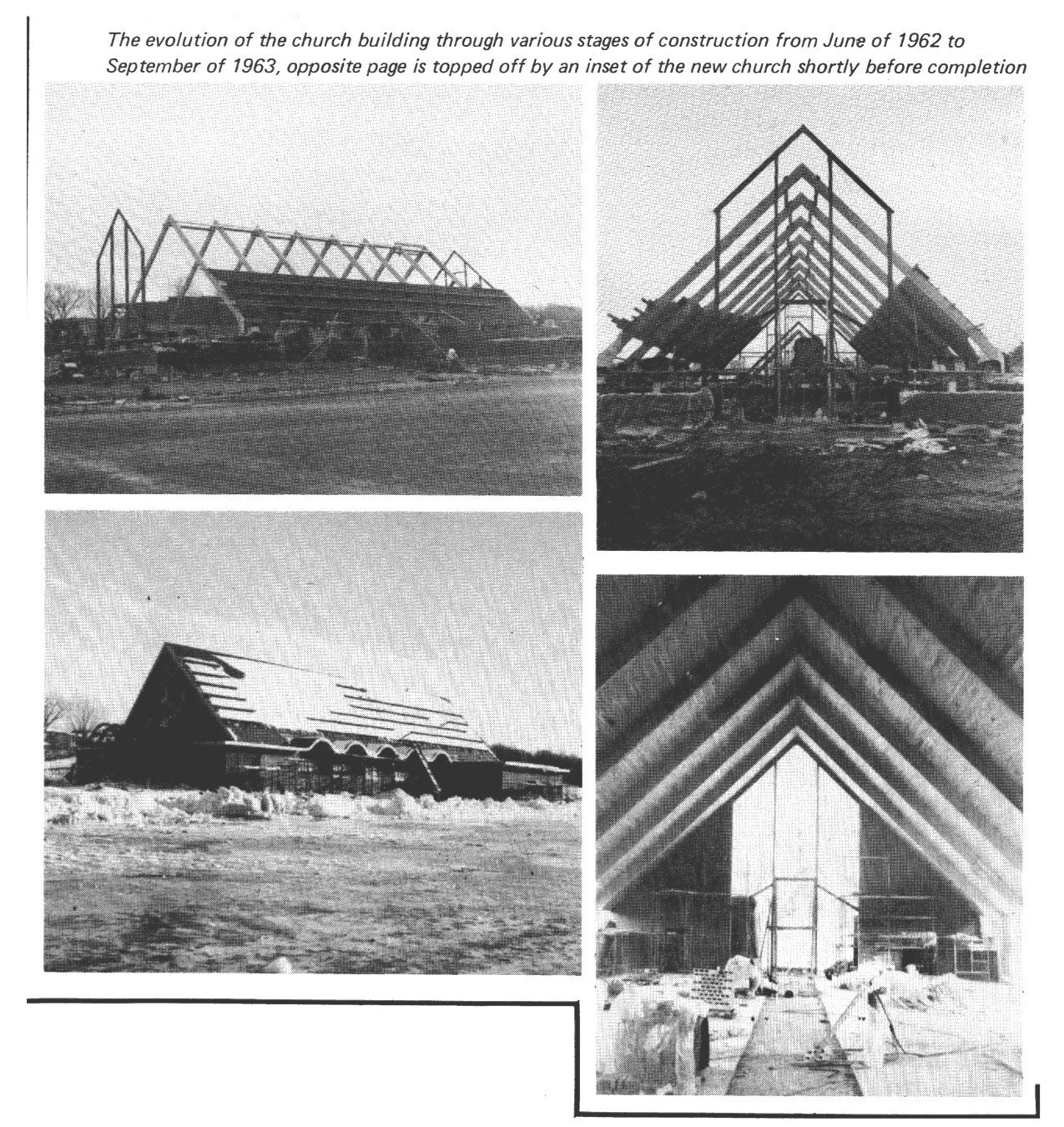
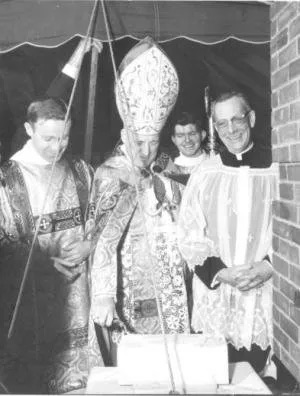
The acquisition of a large plot of ground, totaling fifty acres with a twelve hundred foot frontage on Trapelo Road, had allowed for inclusion of extensive parking areas on either side of the church. There was also room for a front lawn, and landscaping included dotting the lot with rows of maple trees. Thomas H. Fallon and Sons had served as contractors.
In 1986, at the 50th anniversary of the Parish, Pope John Paul II imparted his apostolic blessing on Our Lady Comforter of the Afflicted Church and wrote that we were united with him because we shared his special love “for the poor, the sick and the suffering.”
The Tree of Knowledge logo was created by Betty Collins, the principal in the mid 1980’s. It has well represented the true spirit of “being rooted in Christ” here at Our Lady’s school for nearly 25 years!
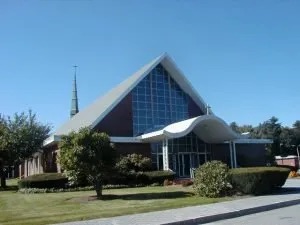

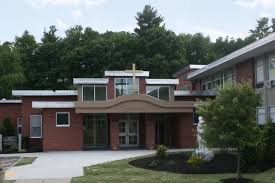

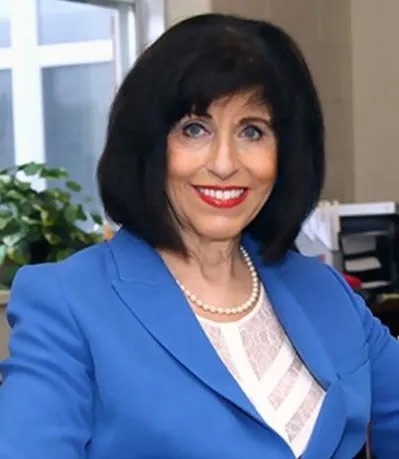
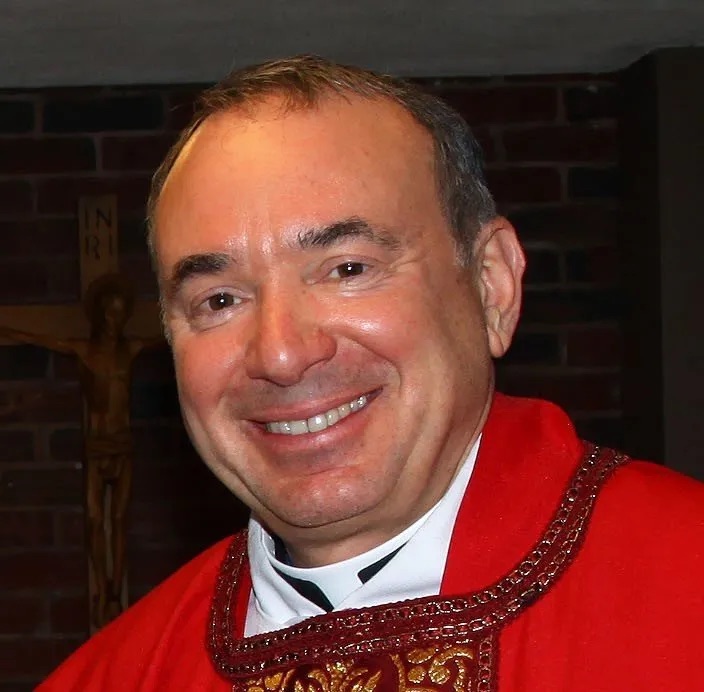
In 1999, we broke ground on the new addition. In September of 2000, the new addition was opened boasting new classrooms, a science lab, music room, chapel, and parish offices.
In 2006, Chandra Minor became the new principal. The school received donations for a new computer lab and SMART Boards. All the text books were updated to the latest copyrights. New programs such as Spanish in every grade, and Pre-K, have opened up our school to more families in the parish and from the community.
In 2008, Father James DiPerri became our pastor. Since then an emphasis on prayer and working together through the intercession of Jesus Christ has brought a new understanding of our Catholic responsibilities to the parish and to our community.
In 2009, under the leadership of Fr. James DiPerri as Pastor and Mrs. Chandra Minor as Principal, Our Lady's School changed its name to Our Lady's Academy to reflect the academic excellence and improvements to the curriculum.
In 2013, Our Lady's Academy completed its re-accreditation process. The accreditation of an institute by New England Association of Schools and Colleges (NEASC) indicates that the school meets or exceeds NEASC rigorous standards and criteria in every facet of the school’s programs. The academy was evaluated by a team of seven individuals from all areas of the educational field ranging from assistant superintendents to teachers and by members from the business community. This process was intense and took many hours of work by our dedicated faculty and administration working together gathering data through self-studies over the past 18 months in the following areas:
Mission ~ Governance ~ Enrollment ~ Curriculum ~ Resources ~ Faculty ~ Evaluation ~ Assessment ~ Health and Safety ~ Infrastructure ~ Finance
In 2013, due to increased enrollment, the need for improved safety and security, and the need for more space for parish and school meetings, an extension to the school building was proposed.
Two classrooms were built on the second floor of the School one for music and the other a new science lab. Construction began Summer of 2015 and completed for opening of the 2017 school year. Cardinal O' Malley blessed Our Lady's Academy during his October 2017 visit, during which visit he also blessed the other improvements made to the church and to the grounds.
By the hand of God and His Mother, Mary, the church and school continues to grow at an amazing rate.
Security cameras were added to the school, parish center and church in 2011, with additional added over the years. Over the past years, many upgrades have been made to the parish and school property.